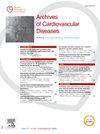Pulmonary embolism in COVID-19 patients in intensive care: Risk factors, management, and prognosis
IF 2.2
3区 医学
Q2 CARDIAC & CARDIOVASCULAR SYSTEMS
引用次数: 0
Abstract
Background
While COVID-19 primarily affects the respiratory system, its impact extends far beyond. Increasing evidence highlights its role in triggering severe thrombotic complications, particularly pulmonary embolism. By worsening hypoxemia and further impairing respiratory function, PE can significantly deteriorate the prognosis of critically ill patients in intensive care. Understanding its incidence, risk factors, and clinical outcomes is essential to improving survival rates.
Objectives
Assess the incidence of PE in COVID-19 in intensive care, identify associated risk factors, and evaluate its impact on mortality.
Methods
A retrospective study was conducted in the ICU of CHU Ibn Rochd in Casablanca between 2020 and 2022. It included 108 patients hospitalized for severe COVID-19 confirmed by PCR, all undergoing clinical, biological, and radiological follow-up. PE was diagnosed through CT pulmonary angiography. D-dimer and other biological markers were analyzed, and statistical assessments were performed to examine correlations between thromboembolic complications and mortality.
Results
PE was diagnosed in 21 patients (19.6%), with 84% showing elevated D-dimer levels. The overall mortality rate was 60.2%, with PE directly involved in 15.7% of deaths. Multivariate analysis identified several independent mortality risk factors, including advanced age, male sex, acute respiratory distress syndrome, septic shock, and thromboembolic complications. While corticosteroid therapy helped reduce pulmonary inflammation, it was linked to worsening respiratory distress in 32.7% of patients.
Conclusion
PE is a severe complication in critical COVID-19 cases, with high mortality. Early monitoring of d-dimer levels and personalized anticoagulation are key to improving outcomes.
重症监护COVID-19患者的肺栓塞:危险因素、管理和预后
虽然COVID-19主要影响呼吸系统,但其影响远远不止于此。越来越多的证据强调其在引发严重血栓并发症,特别是肺栓塞中的作用。PE加重低氧血症,进一步损害呼吸功能,可显著恶化重症患者的预后。了解其发病率、危险因素和临床结果对提高生存率至关重要。目的评估COVID-19重症监护中PE的发生率,确定相关危险因素,并评估其对死亡率的影响。方法对2020 - 2022年在卡萨布兰卡伊本罗氏医院ICU进行回顾性研究。纳入108例经PCR确诊的重症COVID-19住院患者,所有患者均接受临床、生物学和放射学随访。通过CT肺血管造影诊断PE。分析d -二聚体和其他生物标志物,并进行统计评估,以检查血栓栓塞并发症与死亡率之间的相关性。结果21例(19.6%)患者诊断为spe,其中84%患者d -二聚体水平升高。总死亡率为60.2%,PE直接导致15.7%的死亡。多变量分析确定了几个独立的死亡危险因素,包括高龄、男性、急性呼吸窘迫综合征、感染性休克和血栓栓塞并发症。虽然皮质类固醇治疗有助于减轻肺部炎症,但在32.7%的患者中,它与呼吸窘迫恶化有关。结论pe是新冠肺炎危重病例的严重并发症,病死率高。早期监测d-二聚体水平和个性化抗凝治疗是改善预后的关键。
本文章由计算机程序翻译,如有差异,请以英文原文为准。
求助全文
约1分钟内获得全文
求助全文
来源期刊

Archives of Cardiovascular Diseases
医学-心血管系统
CiteScore
4.40
自引率
6.70%
发文量
87
审稿时长
34 days
期刊介绍:
The Journal publishes original peer-reviewed clinical and research articles, epidemiological studies, new methodological clinical approaches, review articles and editorials. Topics covered include coronary artery and valve diseases, interventional and pediatric cardiology, cardiovascular surgery, cardiomyopathy and heart failure, arrhythmias and stimulation, cardiovascular imaging, vascular medicine and hypertension, epidemiology and risk factors, and large multicenter studies. Archives of Cardiovascular Diseases also publishes abstracts of papers presented at the annual sessions of the Journées Européennes de la Société Française de Cardiologie and the guidelines edited by the French Society of Cardiology.
 求助内容:
求助内容: 应助结果提醒方式:
应助结果提醒方式:


